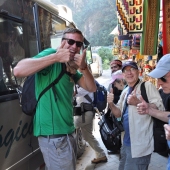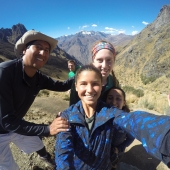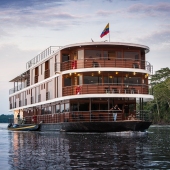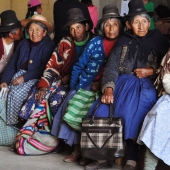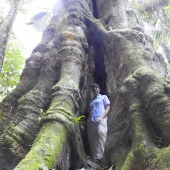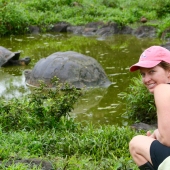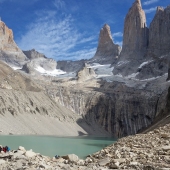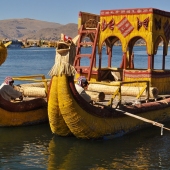The One Experience That Every Traveler Can Expect on Their Trip to Machu Picchu
What "experience" am I talking about? Every single traveler regardless of your age, income or occupation can expect daily interactions with street vendors and micro-business enterprises everywhere you go in Peru. I do mean everywhere. The Peru economy is made up of a plethora of industrious citizens who support themselves by selling something they make or do. While there are a few restrictions, they are free to sell their wares and services any place they choose. Vending is not restricted to places where you would expect to find goods and services for sale, like shops, markets, trasnportation hubs, and dedicated tourism store-fronts. People can sell their products on streets, parking lots and even hiking trails! Although there are a few restrictions on vending, the practice of selling stuff is pervasive in Peru and other developing countries. This is how most working class residents support themselves and their families.
It's not for me to judge the rights of street vendors to choose how they want to make a living.. Is it right or wrong, good or bad? It's just "the way it is."
It has been said that one of the foundations of many latin economies in developing countries, is the often overlooked micro-entrepreneur. Innovative hard-working citizens of all ages can be found in shops, markets, streets and restaurants of all calibers. Travel TV shows and videos often seek out these skilled local experts because that's the kind of insider intel that many viewers are interested in. If not at least for the entertainment value, but also for inspiration and travel ideas.
In spite of the cultural enrichment that street vending and micro-markets bring to the travel experience, many travelers from western societies are baffled by the pervasiveness of the practice of selling literally everywhere. Savvy sellers target spaces where tourists are likely to stroll around on their own, and may set up mini-roadside markets next to parking areas for buses and vans loaded with unsuspecting pilgrims. Indigenous people cleverly set up free demonstrations to attract curious globetrotters to their products and services. I was impressed by a qechua woman who set up a rustic outdoor kitchen to serve warm snacks at the top of Rainbow Mountain! She even had a wooden bench covered with a sheep skin for my friends and I to rest our weary, cold tushes! But many tourists are turned off the the constant enthusiastic invitations to purchase goods or services literally everywhere they go in Peru.
How can travelers prepare for encounters galore with enthusiastic street vendors while traveling to Machu Picchu?
- It's impossible to avoid these encounters with vendors if you intend to walk around and explore the country
- Accept that the majority of these citizens are trying to earn an honest living
- Understand that you are responsible to evaluate the quality of the goods or services. For instance, textiles may be handmade by machines with a blend of synthetic and native wool. Or "pickup" tour guides at the bus stop for Machu Picchu may have various levels of emerging skills. It's up to you to determine if the product or service meets your needs. Fortunately, you have the freedom to decline and move on.
- If you choose to buy something, you are supporting cottage industries.
- In Cusco main Plaza de Armas, the tourist police try to discourage vendors, but the adjoining streets are thick with industrious locals selling hand-made as well as store bought goods.
- The most prevalent sellers in Cusco seem to be young women offering massages, usually within earshot of each other. The cost is so cheap that you wonder how they can do it. They are working for a nearby parlor. They may not be giving you the actual massage. They get a commission if they deliver you to the business owner.
- Weavers, potters and other artisans may offer live demonstrations for free. This is a way for individual experts and small collectives to offer their goods directly to consumers. Travelers who go to the village of Chinchero in the Sacred Valley, and Uros Islands on Lake Titicaca, will have a chance to purchase goods after the demonstrations. Usually the goods are made with locally sourced materials, but may not be entirely native.. Buyer beware. Always ask or consult your tour guide. If you're not sure, just don't buy it.
How to respond to ubiquitous encounters with ambitious vendors during your trip.
- If you know you don't want to come face to face with individual sellers, it's best to avoid visiting places like llama farms or Chinchero weavers' co-ops. These intimate settings offer live demonstrations by local qechua women who will invite you to buy their hand-made textiles. For many travelers, buying products and souvenirs directly from the artisans is preferred and some travelers appreciate this opportunity. If you prefer to avoid these close-up experiences, ask your trip planner before you confirm your itinerary or mention it to your tour guide before you begin your trip to the Sacred Valley.
- in public steets, parking lots and historical sites, it's fine to ignore sales people when they approach you
- Don't make eye contact or initiate conversations
- Don't respond to questions about where you're from, or your first name.
- Comments like, "I'll be back later," or "Maybe next time," are acceptable responses while you keep walking.
Are there any places in Peru where vending does not occur?
I'm happy to report that there is no vending of any kind inside Machu Picchu national park and on the 1-day Inca Trail hike. No one will approach you to sell their wares while you stand in line for the bus in Aguas Calientes, although the line is on a sidewalk conveniently adjacent to small shops selling ponchos, bottled water, hats, sunscreen and even coffee. However, the "pickup" tour guides stand around and may ask if you need guide service. I have found them to be pretty low key. A simple no thank you seems to suffice. The only vending at the entrance to Machu Picchu is a small cafe offering a modest selectoin of sandwiches and drinks. It's easy to miss if you're not looking for it. Of course there's a fee of 2 soles to enter the only restrooms at the national park. Most people are grateful for that.
Hikers on many multi-day treks may run across an occasional spot on the side of the trail where drinks and snacks may be offered by a plucky local entrepreneur willing to go through the trouble of buying and hauling goodies up the mountains on their backs.
The best thing to do is to try not try to worry. Sellers endure plenty of rejections and are usually not affected by the indifference of potential buyers. You should do the same and accept that the plentiful encounters with street vendors on your dream vacation is part of the experience to the Land of the Inca.
.


